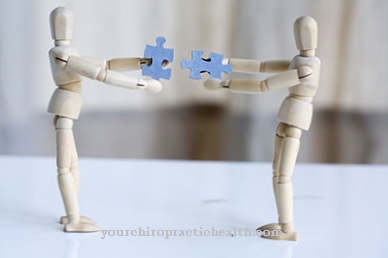A REM sleep behavior disorder (RBD) is a sleep disorder in which complex movements take place in the dream phase. The sick person reacts to certain dream contents by acting aggressively. RBD is often the precursor to Parkinson's disease, Lewy body dementia, or MSA (multiple system atrophy).
What is REM Sleep Behavior Disorder?

© desdemona72 - stock.adobe.com
In the REM sleep behavior disorder it is a parasomnia (abnormal behavior during sleep) that occurs during the REM sleep phase. This leads to vivid dreams, often with aggressive content, in which the person concerned reacts by hitting, kicking or screaming. Often the bed neighbor is attacked and even injured. Self-harm also occurs. The dream is lived out.
However, after awakening there is no memory. The disease is also called a Schenck syndrome or RBD (Rapid eye movement sleep behavior disorder) known. Men are affected to over 90 percent. RBD usually occurs between the ages of 40 and 70. In the majority of cases (over 80 percent), the people affected are over 60 years old. Only very rarely do people under the age of 40 develop a REM sleep behavior disorder.
causes
Synucleinopathy is believed to be the cause of REM sleep behavior disorder. This is a deposition of misfolded alpha-synuclein within nerve cells in the brain stem. Synuclein is responsible for the formation of dopamine. A genetic modification of this protein can lead to a misfolding, whereby its secondary structure is destroyed with the formation of insoluble protein complexes.
On the one hand, this reduces the formation of dopamine and, on the other hand, these deposits block important sections of the brain stem. The motor-inhibiting processes in the brain are switched off during sleep. This in turn means that the dream content can be lived out with the help of movements. Since the synucleins are also responsible for the formation of dopamine, their misfolding leads to a reduction in dopamine production.
Therefore, REM sleep behavior disorder is often an accompanying symptom of Parkinson's disease. This disorder can develop before or during Parkinson's disease. As the resulting deposits damage certain areas of the brain, the consequence of RBD is often Lewy body dementia. In rarer cases, multiple system atrophy (MSA) develops.
Symptoms, ailments & signs
A REM sleep behavior disorder manifests itself in increased motor skills during the REM sleep phase. Patients experience violent dreams, which are mainly about attacks from insects, animals or humans. The victim defends himself by hitting, kicking and screaming. The movements are carried out because the motor skills inhibition is lifted by the incorrectly folded alpha synucleine. The movements are complex, and unlike sleepwalking, there is no leaving the bed.
The behavior of the affected person during sleep, including his speech and screams, is not typical of his behavior in the waking phase. The person concerned can no longer remember the dream after waking up. When waking up, the wake-up action and dream mix. The consequence is endangerment of others and self-endangerment through violent actions. The other phases of sleep, however, are calm and subject to the normal rhythm.
The frequency of sleep disorders ranges from once a week to several times a night. In many cases, RBD is an accompanying symptom of Parkinson's disease. The REM sleep behavior disorder often occurs idiopathically and is the first symptom of Parkinson's disease or Lewy body dementia. Sometimes the disorder is also associated with symptoms of cognitive impairment.
Diagnosis & course of disease
There are several diagnostic tests that can be used to diagnose REM sleep behavior disorder. For this purpose, relatives are interviewed as part of a third-party anamnesis. The patient also gives a self-assessment of the symptoms, using various questionnaires. Neurological examinations are carried out for concomitant diseases of RBD. In this way, REM sleep behavior disorder can be verified in connection with Parkinson's disease or Lewy body dementia.
In addition, the RBD can be determined by a polysomnography. The activity of the mentalis muscle (chin muscle) during the REM sleep phase is examined using an EMG. If the muscle activity is increased, RBD can be assumed.
Complications
Primarily, REM sleep behavior disorder increases the risk of accidents and falling out of bed. Since the person concerned cannot distinguish between dream and wakefulness for a short time after waking up, there is a risk of endangering himself and others. If the person concerned has a mental illness, the behavior disorder can cause traumatic states, delusional behavior and other complications.
Often the REM sleep behavior disorder occurs as the first symptom of Parkinson's disease or Lewy body dementia. As a result, there are correspondingly further complaints and sometimes an increase in the behavioral disorder. Treatment with clonazepam can cause side effects such as muscle weakness, dizziness, unsteady gait and fatigue.
Headache, nausea, skin irritation and urinary incontinence occur rarely. In individual cases, allergic reactions or an allergic shock occur. In children, the drug can provoke premature development of secondary sexual characteristics.
In addition to the typical side effects, melatonin, which is often prescribed at the same time, can also lead to nightmares, hyperactivity and weight gain. Particularly at the beginning of the medication, irritability, restlessness, fatigue and dry mouth can occur, whereby these symptoms disappear after a few days to weeks without further complications in the case of melatonin.
When should you go to the doctor?
REM sleep behavior disorder should always be treated by a doctor. In most cases, self-healing does not occur, and the disease usually cannot be treated by means of self-help either. Treatment by a doctor is therefore essential. As a rule, REM sleep behavior disorder needs to be treated if the person concerned has long-term dreams of insects or other animals that are chasing them while they sleep. The patient usually has to defend himself against these animals in order not to die in his sleep.
The disease can also lead to sleepwalking, which should also be treated to prevent further complications and symptoms. In most cases, the symptoms of REM sleep behavior disorder are registered by outsiders, so that they in particular should make those affected aware of the disease. In many cases, the disease can be treated by a psychologist. However, how long the treatment will last cannot generally be predicted.
Therapy & Treatment
The drug Clonanzepam is currently mainly used to treat idiopathic REM sleep behavior disorder. This medicine belongs to the benzodiazepines and has a calming and muscle relaxant effect. It is taken at bedtime to reduce muscle activity during REM sleep. Even after long-term use there is no loss of effectiveness. Some patients also respond positively to melatonin.
So far, however, there is unfortunately no prospect of a cure for the RBD. The symptoms of the idiopathic form of the disease can be improved. Unfortunately, this has no influence on the development of Parkinson's disease or Lewy body dementia. Adequate studies are not yet available for the treatment of RBD as an accompanying symptom of neurodegenerative diseases. Increasing the dopaminergic dose improves the symptoms of Parkinson's disease, but does not change the frequency and intensity of an existing REM sleep behavior disorder.
You can find your medication here
➔ Medication for sleep disordersprevention
There are no known preventive measures against REM sleep behavior disorder. With a corresponding genetic predisposition, RBD can occur from the age of forty. At the same time, their occurrence can be interpreted as a predisposition to neurodegenerative diseases. It has not yet been clarified whether particular stressful situations could trigger the disease.
According to a Swedish study, physical activity can lower the incidence of Parkinson's disease. To what extent this also applies to REM sleep behavior disorder requires further research.
Aftercare
REM behavior disorder is a sleep disorder, a parasomy. REM means Rapid Eye Movement. These movements often occur while falling asleep or when waking up. NREM is light sleep and deep sleep and manifests itself through a decrease in temperature, change in breathing, a decrease and increase in the pulse and a lower blood pressure.
Symptoms that occur with NREM include sleepwalking and anxiety disorders. When people are sleepwalking, they often don't remember it. Waking up by relatives is also difficult. Problems with REM are the lack of muscle activity, an uneven heartbeat and nightmares. It is therefore a sleep behavior disorder. The dreams that occur often frighten the dreaming by their aggressive thoughts.
The diagnosis is made in the sleep laboratory with the help of the medical history and questionnaires to secure the clinical diagnosis. Video control can also be carried out. Follow-up care must be taken to see whether there is a change in the brain or Parkinson's disease within a few years. Sensory perception, attention and memory are tested. An ultrasound and a CT scan will show the condition of the brain. How the REM behavior disorder develops also depends on the patient's cooperation.
You can do that yourself
If a patient is diagnosed with REM sleep behavior disorder, it is essential to clarify whether this disorder is a concomitant disease and / or heralds the occurrence of further diseases. Only then can appropriate therapies be initiated.
There is no cure for REM sleep behavior disorder. It can only be improved with medication. As a support, most male patients should learn relaxation techniques to perform before going to bed. Jacobson's progressive muscle relaxation is easy to learn. Alternatively, there are also yoga, qigong and tai chi. Even music therapy or EFT tapping therapy could bring relief to the patient.
With a REM sleep behavior disorder, the patient puts himself and others at risk. On the one hand, the risk of accidents is greatly increased because the patient acts out his dream content. In addition, there may be the effects of the drugs that he is given to treat other illnesses and that can lead to unsteady gait or dizziness. Therefore, the bed should be as secure as possible. Sharp objects, loose carpets and other tripping hazards should be removed from the bedroom. A bed guard would also be recommended so that the patient does not accidentally fall out of bed.
In patients with REM sleep behavior disorder, spouses are also at risk at night. If housing allows, this partner should sleep in another room or at least in another, distant bed.













.jpg)

.jpg)
.jpg)











.jpg)